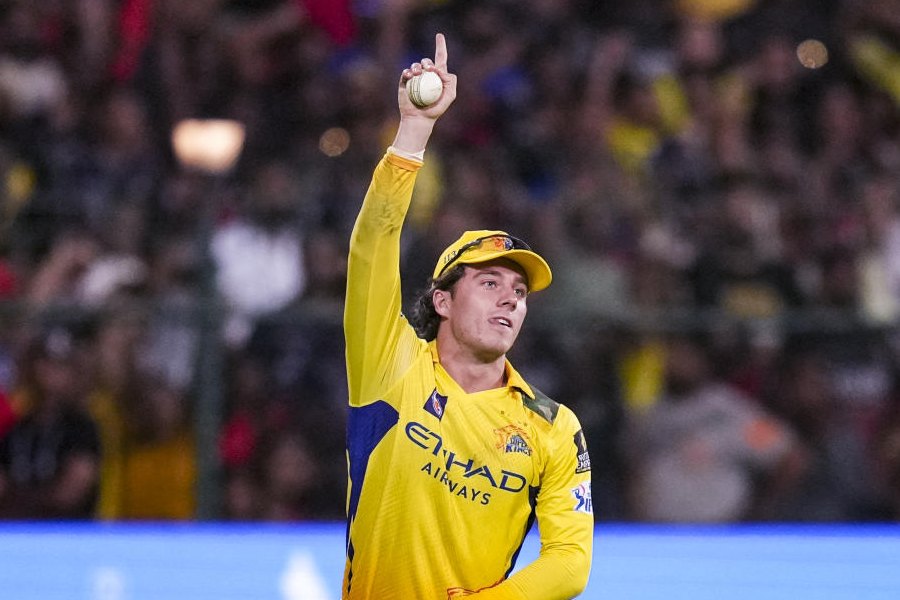.jpg)
Sunrisers Hyderabad
M 11
W 13
A 22.38
E 6.61
I have been watching this year's Indian Premier League (IPL) with great interest. As the tournament enters the business end, two things that have stood out are the resurgence of the wrist-spinners and a very high standard of fielding, and, sadly, the continuing decline of the finger spinner, both left-arm and right-arm.
Wrist-spinning has seen some greats in the past. But in recent years it had become a dying art as leg-spinners had simply vanished from the international scene; the ones that did remain on the scene were not doing that great. But this IPL may see a revival of this rather difficult art.

The margin of error for leg-spinners is very small. Smaller boundaries and heavier bats have made their task that much more difficult. In fact, almost everything is loaded against the wrist-spinner. Bowling under circumstances such as the IPL, and doing rather well speaks of very high skill levels of leg-spinners.
Leg-spinners are generally considered rather expensive in limited-over matches as they are more of purchasers of wickets rather than containers of runs. But the IPL has been different this time around. You look at the top ten wicket-taking bowlers in this IPL and I think four are wrist-spinners.
The reason is fairly simple. The leg-spinners have a natural flight because they have to twist their wrist and bowl. The natural flight is making the batsmen tentative as not many of them can read the ball correctly. That's the reason why many batsmen are going after them without the right technique and the wrist-spinners have won a bagful of wickets. Some of them are very good anyway. They would take wickets on any wicket and in any format.
At a time when everybody knows everybody's strengths and weaknesses, credit to the leg-spinners for doing such a great job in this tournament.
The Royal Challengers Bangalore have preferred to go with two leg-spin bowlers. That was unimaginable till a few years ago, especially in the bang-bang T20 format where batsmen enjoy tremendous advantages.
Imran Tahir of Rising Pune Supergiants is leading the pack with a good haul of wickets. He is quick through the air but a very cunning bowler. He gives me the impression that he has a plan for every batsman.

Rashid Khan, the Afghan leg-spinner playing for the Sunrisers Hyderabad, has been quite a revelation. He has been extremely impressive with his control of the ball and he is very accurate. He doesn't seem to spin his leg-breaks as he bowls them at some pace, but still he is bowling with fair flight and purchase.
Samuel Badree and Yuzvendra Chahal have been outstanding for the Royal Challengers Bangalore. I have seen Badree before and he is a much improved bowler, not one scared of taking the risks. Chahal is a better bowler when he flights the ball. Although Bangalore haven't performed well this year, hats off to Virat Kohli for standing by these two bowlers.
Kuldeep Yadav of Kolkata Knight Riders has brought in fresh air, and fresh thinking, to the game with his chinaman googly bowling. He is practicing an art that is very difficult to master, and very rare these days. He may not have got many wickets, but he has shown that he has a large heart and he is not afraid of going for runs while trying to take wickets, always the hallmark of a good spinner.
T20 offers a great chance to take wickets simply because batsman will go after you. No doubt about that. It's a given that you will go for runs but while you go for runs, you have to make batsmen commit mistakes. That's where the spinner's craft lies, and that's where wrist spinners have prospered this season.
On the other hand, the decline of finger spinners is sadly apparent. None of them has looked to get the batsmen out and they are not able to spin the ball unless the wickets are bad. Just watching an off-spinner bowling down the leg side and giving away two or three wides in an over makes it obvious that they are in a defensive mode. Almost all of them appear to have an open chested action which deprives them of the subtleties of their chosen craft and being effective.
The fact that wrist-spinners have bagged more than 80 wickets in the tournament so far, and the finger-spinners have only got a little over 50 proves my point.
I am looking at the actions of the finger-spinners and I can say with some authority that many of them are simply not trying to spin the ball. Most of them are just rolling it. Unless the pitches are assisting them, they cannot take wickets. That's not a healthy sign for the great spectacle of the game, which has always been about a crafty spinner against a batsman using his feet.
The off-spinners are bowling way too fast and flat. Both the left-arm and right-arm spinners are reasonably unsuccessful in this tournament. But since a left-arm finger-spinner's ball turns away from the bat, it offers these bowlers some hope of getting wickets. If you look at some of the left-arm spinners like Pawan Negi (Royal Challengers Bangalore), Krunal Pandya (Mumbai Indians) and Shahbaz Nadeem (Delhi Daredevils), they have done relatively better compared with their right-arm counterparts.
My point is that as long you spin and flight the ball, you will confuse the batsman. You will tempt and tantalise him, you will be able to draw him into risks. In order to succeed as a spinner you must make the batsman feel tentative on how to play you, and at the same time enticed into hitting you. As a captain why would I want to bowl a spinner who's afraid to spin a ball and wants to fire the ball in at 90 to 95 kilometres an hour, much like some slow medium seamer in English conditions?
If you look at the fast bowlers in this IPL, they have been containing batsmen and taking wickets bowling slower balls. Fast bowlers like M.J. McClenaghan (Mumbai Indians) and Tymal Mills (Royal Challengers Bangalore) are two exponents of effective slower balls. In fact, fast bowlers in this IPL are bowling slower and slower and the off-spinners are bowling faster and faster. I think it's a bit of a parody.
Coming back to wrist-spinners, patience and control are essential to be successful. But another important element that you cannot overlook is the support of the captain. It is quite possible that wrist-spinners will go for runs almost every over. But if the captain believes that his wrist-spinner is a potential match-winner, he will be backed the whole way. That has happened in this tournament.
I also feel that only mature wrist-spinners should be thrown into the T20 cauldron as it is easy to lose confidence if you go for runs. For instance, I feel that Kuldeep Yadav should first bowl more often at the first-class level and hone his skills rather than at the IPL. He is a special talent and he should concentrate more on the Tests. Or, he should not change his style in T20.
If we look at the international scene, Yasir Shah of Pakistan has been bowling well and he just won them a Test match in the West Indies. He has nice variations and like any good leg-spinner he is not afraid of flighting the ball and using variations fearlessly. I hope more and more wrist-spinners come up at the international level.
Looking at how the batsmen approach a leg-spinner, I dare say that most of them cannot read them. Rashid Khan has, in fact, got most of his scalps when batsmen have been in defensive, not offensive mode; that's because they can't read which way he's going to go. This IPL may convince many international teams in general and captains in particular that it pays to have a good and willing wrist-spinner on the team.
- As told to V. Kumara Swamy

.jpg)








